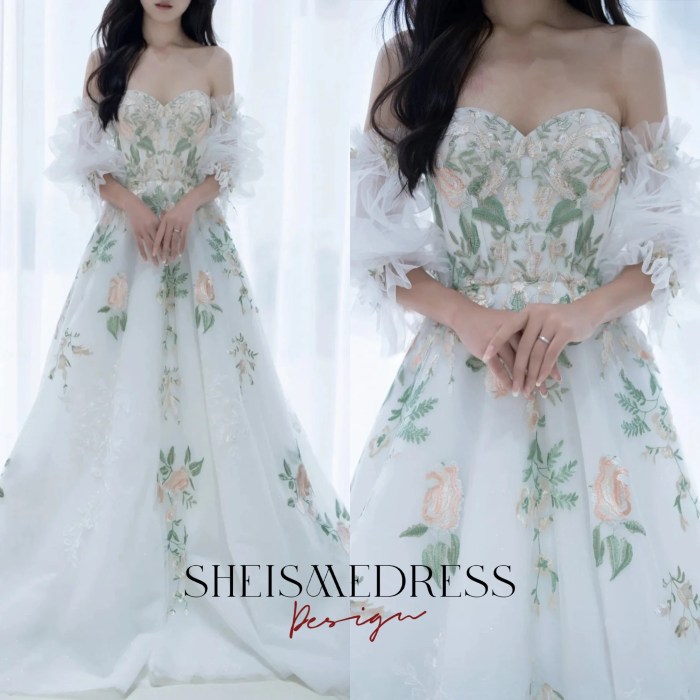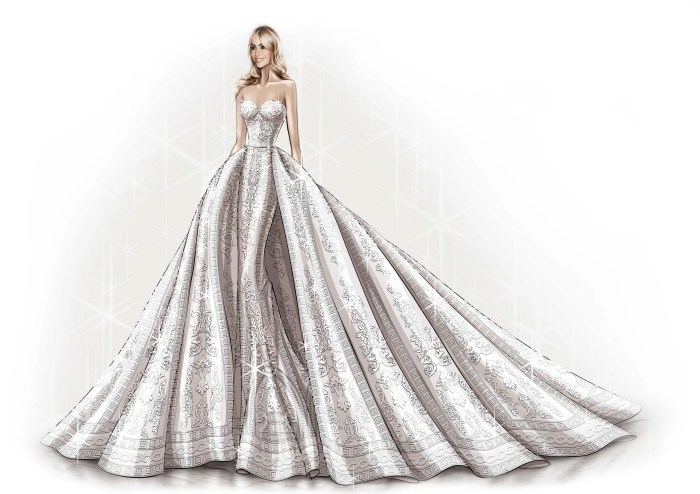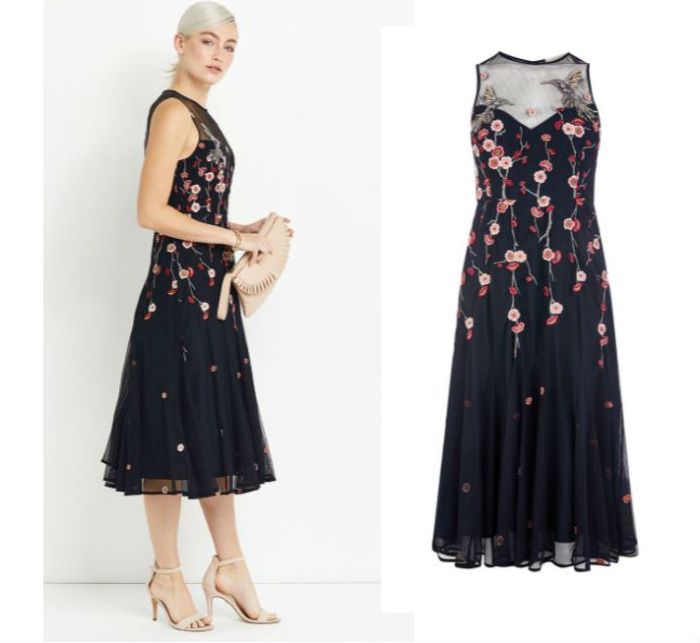Types of Wedding Guest Dresses
Dresses worn to weddings – Choosing the right dress for a wedding depends heavily on the formality of the event and the venue. Understanding the nuances of dress styles ensures you’ll look and feel your best while respecting the occasion.
Dress Styles for Various Wedding Settings
| Dress Style | Fabric | Length | Appropriateness |
|---|---|---|---|
| A-line Midi Dress | Silk, Chiffon, Lace | Midi (Knee-length to mid-calf) | Semi-formal weddings, garden parties, cocktail receptions |
| Floor-Length Gown | Silk, Satin, Velvet | Floor-length | Formal weddings, black-tie events |
| Cocktail Dress | Crepe, Jersey, Lace | Knee-length to mid-thigh | Semi-formal to formal weddings, evening receptions |
| Sundress | Cotton, Linen, Chambray | Knee-length or midi | Casual beach weddings, daytime garden parties |
The A-line midi dress is versatile and flattering on various body types. Its silhouette is universally appealing, and it can be made from a variety of fabrics, offering options for different seasons and levels of formality. Necklines can range from simple round necks to more elaborate V-necks or halter necks, while sleeves can be sleeveless, short, or long. The floor-length gown, often reserved for black-tie or formal weddings, exudes elegance and sophistication.
Fabrics like silk and satin create a luxurious feel, while velvet adds a touch of richness. Necklines can be simple or dramatic, and sleeves can range from strapless to long and flowing. Cocktail dresses offer a balance between formality and fun. They are typically shorter than floor-length gowns but more elegant than a sundress. The sundress, ideal for casual daytime weddings, provides comfort and style.
Linen and cotton are breathable choices for warmer weather, while different necklines and sleeve lengths allow for customization.
Three Wedding Guest Outfit Ideas
Here are three outfit ideas demonstrating the versatility of wedding guest attire:
- Outfit 1 (Formal): Floor-length navy blue silk gown with a V-neck and long sleeves, paired with silver drop earrings, a small clutch, and elegant heels.
- Outfit 2 (Semi-formal): Emerald green A-line midi dress in chiffon with a scoop neckline and flutter sleeves, accessorized with gold statement necklace, a chain bag, and ankle strap heels.
- Outfit 3 (Casual): Floral knee-length sundress in cotton, paired with delicate gold necklace, espadrille wedges, and a straw tote bag.
Dress Code Etiquette
Understanding and adhering to the dress code demonstrates respect for the couple and the overall tone of the wedding. Ignoring the dress code can be considered disrespectful and can make you feel out of place.
Appropriate Attire for Different Formality Levels
Dress codes vary significantly in formality. Understanding the distinctions is crucial for choosing the right attire. A casual wedding might allow for sundresses and khakis, while a black-tie event requires floor-length gowns and tuxedos. Semi-formal weddings often permit cocktail dresses and suits, and formal weddings usually call for floor-length gowns and elegant suits.
Common Dress Code Faux Pas, Dresses worn to weddings
Wearing white or overly revealing attire is generally considered inappropriate for wedding guests. Similarly, attire that is too casual for the specified dress code should be avoided. Matching the wedding party’s attire, or wearing anything that overshadows the bride, should also be avoided.
Color Considerations
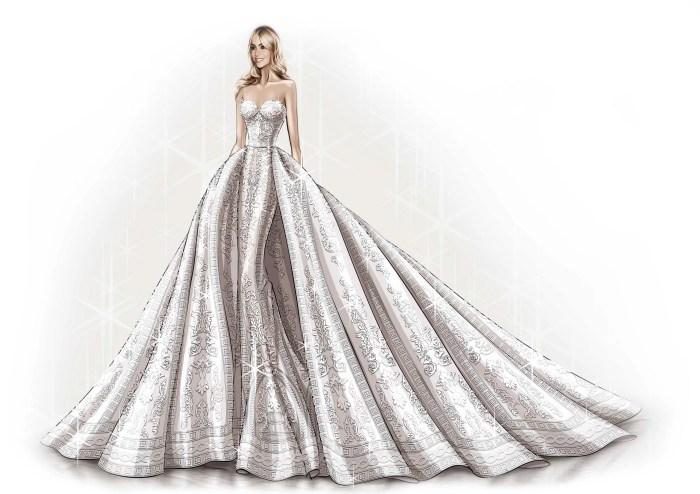
Source: vogue.com
Color choices significantly impact the overall look and can have cultural connotations. Certain colors might clash with the wedding’s theme or be considered inappropriate in specific cultures.
Choosing a dress for a wedding often involves careful consideration of style and appropriateness. The overall aesthetic, from the fabric to the cut, should reflect the event’s formality. For a more relaxed atmosphere, perhaps consider pairing your outfit with a calming visual element in your home, like the beautiful paired images for senior living rooms found here: bilderpaare für wohnzimmer für senioren.
Returning to wedding attire, remember the importance of comfortable yet elegant footwear to complete your look.
Color Selection Guide for Various Skin Tones
Warm skin tones often look best in earthy tones like greens, oranges, and yellows, while cool skin tones often complement blues, purples, and pinks. However, personal preference should always be a deciding factor. Experimentation is key to finding the colors that flatter your skin tone best.
Cultural Significance of Wedding Attire Colors
White is traditionally associated with purity and innocence in many Western cultures, making it generally inappropriate for guests. However, other cultures might have different color associations; therefore, research is advised, especially if attending a culturally diverse wedding.
Fabric and Material Choices: Dresses Worn To Weddings
Fabric selection depends on several factors, including the season, weather, and formality of the event.
Suitable Fabrics for Wedding Guest Dresses
Silk, chiffon, lace, and cotton are popular choices for wedding guest dresses. Silk and satin offer a luxurious feel, suitable for formal events. Chiffon and lace add a touch of elegance and are appropriate for various settings. Cotton and linen are more comfortable options for warmer weather, while heavier fabrics like velvet are suitable for colder months.
Fabric Properties
Silk is luxurious but requires delicate care. Chiffon is lightweight and airy. Lace adds a touch of sophistication. Cotton is breathable and easy to care for. The choice depends on comfort, drape, and maintenance preferences.
Best Fabrics for Different Weather Conditions
Lightweight fabrics like cotton, linen, and silk are best for hot weather weddings. For cold weather, velvet, wool, or heavier silks are more suitable.
Accessories and Styling
Accessories can elevate a simple dress, creating a cohesive and stylish look. Careful consideration of jewelry, handbags, and shoes is crucial.
Accessorizing Wedding Guest Dresses
Jewelry should complement the dress and not overpower it. A statement necklace might pair well with a simple dress, while smaller earrings might be better suited to a more elaborate gown. Handbags should be appropriately sized for the event, and shoes should be comfortable and stylish. The overall goal is to create a balanced and harmonious look.
Hair and Makeup
Hairstyles and makeup should complement the dress and the overall formality of the wedding. A sleek updo might be appropriate for a formal event, while a more relaxed hairstyle might be suitable for a casual wedding. Makeup should be elegant and appropriate for the occasion.
Illustrative Examples of Wedding Guest Dresses
Here are detailed descriptions of three different dresses and scenarios illustrating appropriate attire.
Three Detailed Dress Descriptions
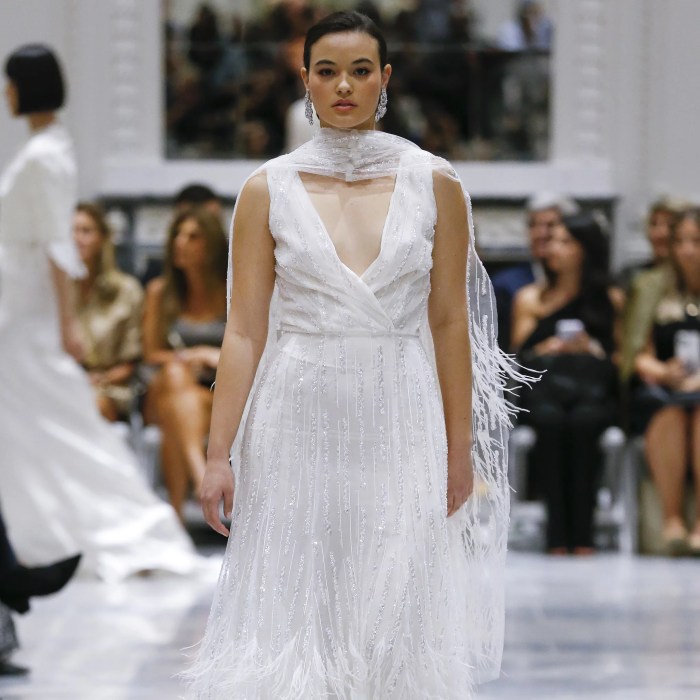
Source: popsugar-assets.com
- Floor-length Gown: A flowing, emerald green silk gown with a sweetheart neckline and spaghetti straps. Features include a fitted bodice, a flowing skirt, and a subtle slit in the skirt. Accessories include delicate gold earrings, a small clutch, and strappy heels.
- Midi-length Cocktail Dress: A blush pink lace cocktail dress with a V-neck and three-quarter sleeves. Features include a fitted waist and a flared skirt. Accessories include pearl earrings, a small chain bag, and pointed-toe heels.
- Knee-length Sundress: A vibrant floral-print cotton sundress with a halter neck and a relaxed fit. Features include a tiered skirt and a drawstring waist. Accessories include a straw hat, espadrille sandals, and a straw tote bag.
Appropriate Dresses for Different Wedding Scenarios
- Garden Wedding: A midi-length floral-print dress in a lightweight fabric like chiffon or cotton. The dress might have a flowy skirt and sleeves, and accessories could include a wide-brimmed hat and sandals. The setting features lush greenery, floral arrangements, and potentially a rustic backdrop.
- Church Wedding: A knee-length or midi-length dress in a more formal fabric such as silk or lace. The dress might be a classic A-line or sheath style, with more modest neckline and sleeve length. Accessories might include elegant jewelry and heels. The setting features a traditional church architecture, stained-glass windows, and potentially a formal atmosphere.
- Beach Wedding: A knee-length or maxi-length sundress in a lightweight and breathable fabric like cotton or linen. The dress could be simple and flowy, and accessories might include a straw hat, sandals, and a beach bag. The setting features a sandy beach, ocean views, and a relaxed atmosphere.
FAQ Section
What if the invitation doesn’t specify a dress code?
If no dress code is specified, err on the side of semi-formal attire. A cocktail dress or a stylish pantsuit are generally safe choices.
Can I wear white to a wedding?
Generally, it’s best to avoid white, ivory, or cream as these are traditionally reserved for the bride. Consider a pastel shade or a bold color instead.
How do I choose a dress that flatters my body type?
Consider your body shape and choose a silhouette that accentuates your best features. Consult a stylist or browse online resources for advice tailored to your body type.
What should I do if I receive a wedding invitation late and don’t have time to buy a new dress?
If time is limited, choose a dress you already own that fits the occasion’s formality. Accessorize thoughtfully to elevate the look.
What are some budget-friendly options for wedding guest dresses?
Consider shopping at department stores, online retailers, or consignment shops for affordable yet stylish options. You can also rent a dress for a special occasion.

